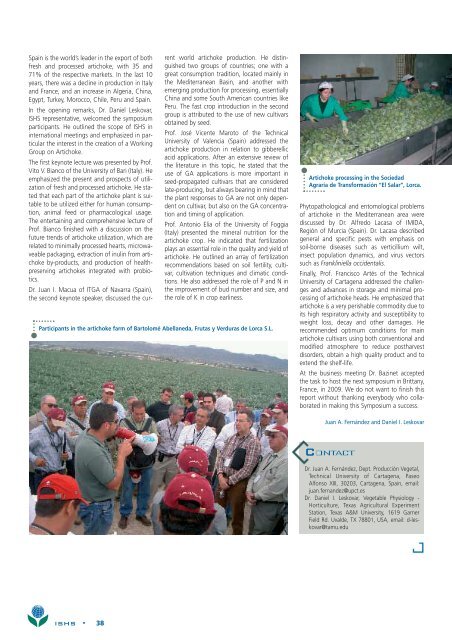Chronica - Acta Horticulturae
Chronica - Acta Horticulturae
Chronica - Acta Horticulturae
Create successful ePaper yourself
Turn your PDF publications into a flip-book with our unique Google optimized e-Paper software.
Spain is the world’s leader in the export of both<br />
fresh and processed artichoke, with 35 and<br />
71% of the respective markets. In the last 10<br />
years, there was a decline in production in Italy<br />
and France, and an increase in Algeria, China,<br />
Egypt, Turkey, Morocco, Chile, Peru and Spain.<br />
In the opening remarks, Dr. Daniel Leskovar,<br />
ISHS representative, welcomed the symposium<br />
participants. He outlined the scope of ISHS in<br />
international meetings and emphasized in particular<br />
the interest in the creation of a Working<br />
Group on Artichoke.<br />
The first keynote lecture was presented by Prof.<br />
Vito V. Bianco of the University of Bari (Italy). He<br />
emphasized the present and prospects of utilization<br />
of fresh and processed artichoke. He stated<br />
that each part of the artichoke plant is suitable<br />
to be utilized either for human consumption,<br />
animal feed or pharmacological usage.<br />
The entertaining and comprehensive lecture of<br />
Prof. Bianco finished with a discussion on the<br />
future trends of artichoke utilization, which are<br />
related to minimally processed hearts, microwaveable<br />
packaging, extraction of inulin from artichoke<br />
by-products, and production of healthpreserving<br />
artichokes integrated with probiotics.<br />
Dr. Juan I. Macua of ITGA of Navarra (Spain),<br />
the second keynote speaker, discussed the cur-<br />
rent world artichoke production. He distinguished<br />
two groups of countries; one with a<br />
great consumption tradition, located mainly in<br />
the Mediterranean Basin, and another with<br />
emerging production for processing, essentially<br />
China and some South American countries like<br />
Peru. The fast crop introduction in the second<br />
group is attributed to the use of new cultivars<br />
obtained by seed.<br />
Prof. José Vicente Maroto of the Technical<br />
University of Valencia (Spain) addressed the<br />
artichoke production in relation to gibberellic<br />
acid applications. After an extensive review of<br />
the literature in this topic, he stated that the<br />
use of GA applications is more important in<br />
seed-propagated cultivars that are considered<br />
late-producing, but always bearing in mind that<br />
the plant responses to GA are not only dependent<br />
on cultivar, but also on the GA concentration<br />
and timing of application.<br />
Prof. Antonio Elia of the University of Foggia<br />
(Italy) presented the mineral nutrition for the<br />
artichoke crop. He indicated that fertilization<br />
plays an essential role in the quality and yield of<br />
artichoke. He outlined an array of fertilization<br />
recommendations based on soil fertility, cultivar,<br />
cultivation techniques and climatic conditions.<br />
He also addressed the role of P and N in<br />
the improvement of bud number and size, and<br />
the role of K in crop earliness.<br />
Participants in the artichoke farm of Bartolomé Abellaneda, Frutas y Verduras de Lorca S.L.<br />
Artichoke processing in the Sociedad<br />
Agraria de Transformación “El Salar”, Lorca.<br />
Phytopathological and entomological problems<br />
of artichoke in the Mediterranean area were<br />
discussed by Dr. Alfredo Lacasa of IMIDA,<br />
Región of Murcia (Spain). Dr. Lacasa described<br />
general and specific pests with emphasis on<br />
soil-borne diseases such as verticillium wilt,<br />
insect population dynamics, and virus vectors<br />
such as Frankliniella occidentalis.<br />
Finally, Prof. Francisco Artés of the Technical<br />
University of Cartagena addressed the challenges<br />
and advances in storage and minimal processing<br />
of artichoke heads. He emphasized that<br />
artichoke is a very perishable commodity due to<br />
its high respiratory activity and susceptibility to<br />
weight loss, decay and other damages. He<br />
recommended optimum conditions for main<br />
artichoke cultivars using both conventional and<br />
modified atmosphere to reduce postharvest<br />
disorders, obtain a high quality product and to<br />
extend the shelf-life.<br />
At the business meeting Dr. Bazinet accepted<br />
the task to host the next symposium in Brittany,<br />
France, in 2009. We do not want to finish this<br />
report without thanking everybody who collaborated<br />
in making this Symposium a success.<br />
Juan A. Fernández and Daniel I. Leskovar<br />
CONTACT<br />
Dr. Juan A. Fernández, Dept. Producción Vegetal,<br />
Technical University of Cartagena, Paseo<br />
Alfonso XIII, 30203, Cartagena, Spain, email:<br />
juan.fernandez@upct.es<br />
Dr. Daniel I. Leskovar, Vegetable Physiology -<br />
Horticulture, Texas Agricultural Experiment<br />
Station, Texas A&M University, 1619 Garner<br />
Field Rd. Uvalde, TX 78801, USA, email: d-leskovar@tamu.edu<br />
ISHS • 38
















